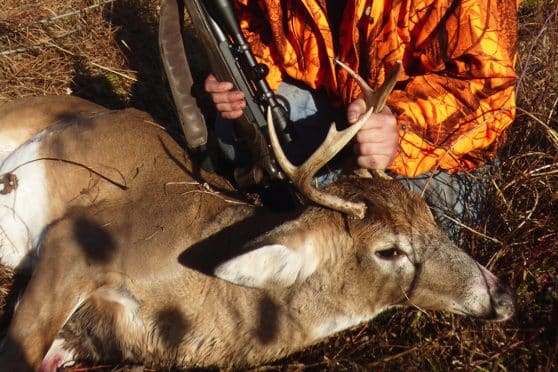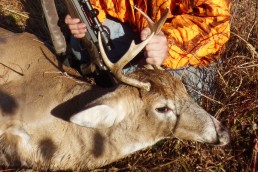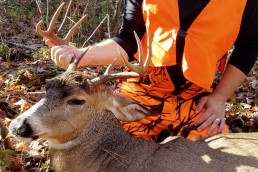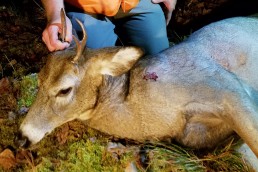Deer Camp 2016: Days 3–5
SHARE THIS POST
Though we had taken two bucks, despite seeing the fewest deer ever on opening weekend, we knew bucks-only hunting was about to become even more difficult. Twenty-five years of hunting and studying mature bucks in this area had taught us by day three of firearm deer hunting season that most bucks 2 1/2 years old and all bucks 3 1/2 or older fully realize they’re being hunted by many.
Though we hunt in ways that alarm very few whitetails, and therefore expect our especially elusive wolf-country bucks to remain in their ranges throughout the rest of the hunting season, their habits and behavior would now begin to change dramatically and they’d begin to do what they did to survive during previous firearm hunting seasons. For example, with rare exceptions, most of their breeding-related activities would now be limited to nighttime hours only. A few older bucks would become completely nocturnal, and virtually impossible to hunt. Most—plus many does—would quit feeding an hour or more earlier in the morning with some heading back to the bedding areas at sunrise; few would begin feeding again before sunset. If there were moonlight before sunrise in the morning, few would be active after sunrise. If there were moonlight at sunset, few would begin feeding again until it was dark. They’d now be especially sensitive to winds that mask sounds made by hunters on foot, forsaking daylight feeding hours while the winds exceed 15 mph. Older bucks would begin traveling off-trail, sticking to dense cover, over 50 percent of the time.
Most astonishingly, some older bucks (and some older does), will begin turning the tables on us by monitoring trails and stand sites we used daily, beginning with our predawn hikes to new stand sites, making it easy to avoid us. Bucks that do this—with fresh tracks and droppings regularly discovered on top of our previously made tracks downwind of our new stand sites while returning to camp midday or evening—are especially frustrating to hunt one-on-one.
To make matters worse, deer numbers in our region were at their lowest in 26 years (about six per square-mile), with no snow cover, and temperatures had been in the 60s and 70s with strong southerly winds blowing unabated throughout opening weekend. A high of 52 degrees was forecasted for this third day of the season and the wind was again blowing from the south. With winter coats good for 45-below zero now covering their bodies, our whitetails would again be reluctant to move about during daylight hours. Not surprisingly, none of us saw deer that day.
At 4 a.m. on day four the temperature outside was 39 degrees, and the winds had shifted to out of the northwest, at last making it possible to use promising stand sites selected pre-season that could not be approached from the south. A high of 47 degrees did little to improve hunting, however. Dry grasses and soil and fallen leaves made it difficult to discern fresh deer tracks, the first vital step to our most productive hunting method: opportunistic stand-hunting. The few fresh deer signs we most commonly came across were droppings, some mature-buck-sized, but again, none of us saw deer.
That evening, we decided to make some changes ourselves.
“From now on,” I suggested, “let’s key on (stand-hunt near) the fresh deer signs we’re most likely to find under present conditions, namely droppings, and especially fresh, 1/2-inch-long, mature-doe-sized droppings close to feeding areas. With breeding in progress, one or more of us will then likely to end up near a doe in heat accompanied by a dominant breeding buck.”
Are you enjoying this post?
You can be among the first to get the latest info on where to go, what to use and how to use it!
Two shots a minute apart were heard at 9:30 a.m. a mile or more north of where I sat facing a cool northwest wind on day five. As expected, upon returning to camp at noon, I discovered my plastic toboggan was missing, meaning someone in camp had taken a buck.
On the table in our tent was a note hastily scrawled by my son John: “Got a 5-pointer at the Moose Mountain clear-cut. Tyler (my grandson) is helping me bring it in.”
When I later got to my stand site on that outcropping on east side of the clear-cut, John said he had begun the moment he and Tyler had reached camp, with the buck laced to the toboggan.
“I heard a deer moving away from the base of that 10-foot tall wall right in front of me,” John said. “It was too dark to see it well and legal shooting time was still 30 minutes away so I simply sat back watched it hoping it would still be near at first light. I could see it had multi-tined antlers (it should have been a 6-pointer, but one tine was missing). Before long, however, it began heading south. It was apparent it hadn’t positively identified me, not snorting or bounding away with its tail up. I decided to try to fool it into believing it had merely heard other deer on top of the outcropping. I dug my sheds from my pack and rattled them a bit, holding them high enough for the buck to see. When legal shooting time finally began, however, the buck was nowhere in sight. At that point I kept thinking about what you have often said and written: ‘If whitetails near your stand site hear your footsteps as you approach but they are too soft to positively identify you, they won’t abandon the area.’ I kept hoping this would be the case this time.
“Two hours later, I again heard what sounded like a deer moving nearby, this time on my left. Suddenly there it was, the same buck right in front of me about 10 yards out from the front of the outcropping. After my shot, it ran about 50 yards and went down. Deciding a finishing shot was needed, I then took aim and fired again. Amazingly, the buck was lying exactly where you had knelt to measure and photograph some fresh 5/8-inch droppings while we were scouting three weeks ago, then predicting someone would take a 2 1/2-year-old buck there.”
“Congratulations,” I said to him, shaking John’s hand and grinning.
Tough as hunting has been—few shots heard anywhere—and should be, this is turning out to be a fine hunting season for us Nordbergs after all.
MWO
SHARE THIS POST
Did you enjoy this post?
You can be among the first to get the latest info on where to go, what to use and how to use it!
Dr. Ken Nordberg
Based on his 55 years of field research, Dr. Ken Nordberg has written more than 800 magazine articles, 12 books on whitetails—including the famous Whitetail Hunter’s Almanac series—five books on black bear hunting and produced Buck and Bear Hunting School videos. You may peruse his encyclopedic website with whitetail hunting tips: drnordbergondeerhunting.com, his blog: drnordbergondeerhunting.wordpress.com, or social media pages.



